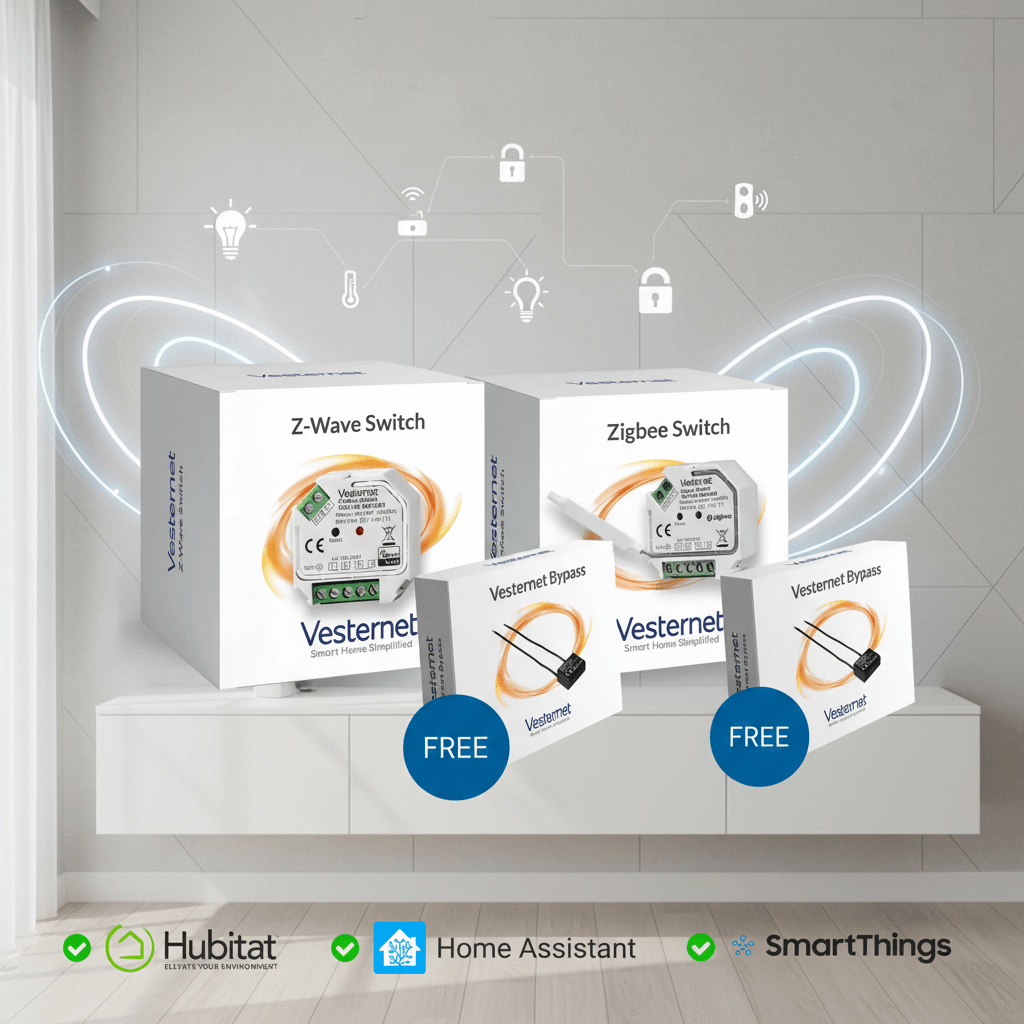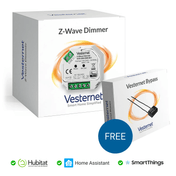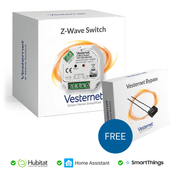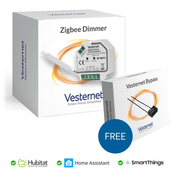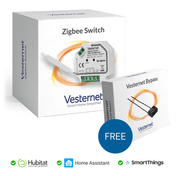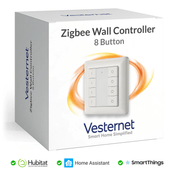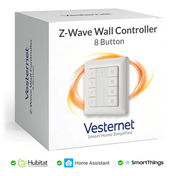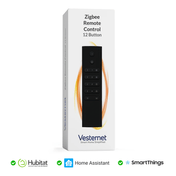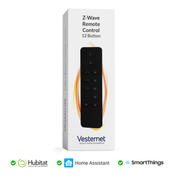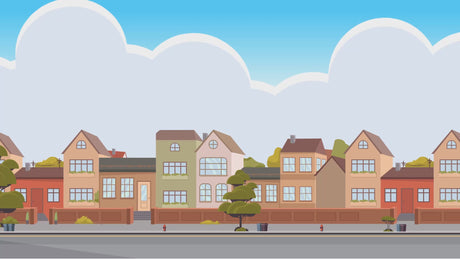Choosing between Z-Wave and Zigbee protocols for smart lighting has become increasingly complex as both technologies mature and offer compelling advantages. The Vesternet Z-Wave Switch and Vesternet Zigbee Switch exemplify this challenge, delivering similar core functionality whilst taking fundamentally different approaches to smart home integration and network communication.
This detailed comparison will guide you through the technical nuances, practical implications, and real-world performance differences between these two sophisticated switches. Whether you're building your first smart home setup, expanding an existing system, or seeking the optimal balance between flexibility and functionality, understanding these distinctions will inform your decision-making process.
At Vesternet, our deep expertise spans both Z-Wave and Zigbee ecosystems, developed through years of engineering custom integrations and supporting thousands of installations. This unbiased analysis draws from technical specifications, customer feedback, and extensive testing to help you make the most informed choice for your specific requirements.

Understanding the Z-Wave Switch Architecture
The Vesternet Z-Wave Switch operates within the established Z-Wave mesh networking protocol, creating a self-healing network where each device acts as a signal repeater. This architecture ensures reliable communication throughout your home, with messages automatically finding the best path between your hub and the switch.
Core Technical Capabilities
- Supports both 2-wire (no neutral wire) and 3-wire installations with included bypass accessory
- Configurable for momentary or toggle switch operation to match existing wall switches
- Customisable power failure recovery states for specific appliance requirements
- Native integration with Home Assistant via Z-Wave JS UI for comprehensive automation control
The switch's sophisticated configuration options extend beyond basic on/off control, offering precise power management and operational flexibility that particularly benefits users with specific automation requirements or existing electrical installations that need accommodation.

Exploring the Zigbee Switch Design Philosophy
The Vesternet Zigbee Switch embraces a more flexible networking approach, capable of operating independently or within larger Zigbee mesh networks. This design philosophy prioritises versatility and energy efficiency, making it suitable for both simple installations and complex smart home ecosystems.
Distinctive Operational Features
- Hub-free operation capability for standalone installations paired directly with controllers
- Compatible with both no neutral wire and neutral wire configurations using bypass accessory
- Seamless integration with Home Assistant through Zigbee2MQTT or ZigbeeZHA protocols
- Energy-efficient communication reducing overall system power consumption
This standalone capability distinguishes the Zigbee switch from traditional smart switches, allowing immediate functionality without requiring a central hub whilst maintaining the option to integrate into broader automation systems as needs evolve.
Protocol Capabilities and Installation Flexibility Compared
Both switches accommodate challenging electrical installations where no neutral wire exists, a common limitation in older properties. The included bypass accessories stabilise operation with low-load LED lighting, ensuring reliable performance regardless of your existing wiring configuration.

Installation Scenarios
- 2-wire (no neutral) installations: Both switches perform identically with bypass accessory
- 3-wire (neutral wire) installations: Enhanced stability and broader lighting compatibility
- Retrofit situations: Minimal electrical modification required for either switch
The Z-Wave switch offers superior configuration flexibility through its momentary/toggle switch compatibility, allowing you to retain existing wall switches or upgrade to momentary controls for aesthetic consistency. This adaptability proves particularly valuable when matching other lighting controls throughout your home.
Power Management Differences
- Z-Wave: Configurable power failure states (ON, OFF, or previous state)
- Zigbee: Standard power restoration to OFF state
- Hub dependency: Z-Wave requires constant hub connection, Zigbee offers standalone operation
The Z-Wave switch's configurable power failure behaviour provides crucial functionality for specific appliances like refrigerators or irrigation systems, where automatic restoration or maintained shutdown states are essential for proper operation or safety considerations.
Real-World Responsiveness and Network Reliability
Network performance varies significantly between these protocols under typical home conditions. Z-Wave operates on a dedicated frequency band (868.4MHz in Europe), reducing interference from WiFi networks, Bluetooth devices, and microwave ovens that commonly disrupt 2.4GHz communications.
Performance Characteristics
- Z-Wave: Consistent response times, less prone to interference, longer range per hop
- Zigbee: Faster initial pairing, energy-efficient operation, broader device ecosystem
- Mesh stability: Both protocols self-heal, but Z-Wave offers more predictable routing
Zigbee's 2.4GHz operation enables faster data transmission and broader compatibility with other smart home devices, though it requires careful channel selection in environments with heavy WiFi usage. The protocol's energy efficiency benefits battery-powered devices but provides less advantage for permanently powered switches.
Range and Coverage Considerations
- Z-Wave typically achieves 30-100 metres between devices with better wall penetration
- Zigbee offers 10-20 metre range but compensates with more devices acting as repeaters
- Both protocols strengthen with additional mains-powered devices in the network
Z-Wave Switch Advantages and Limitations
The Z-Wave switch excels in scenarios requiring precise control and configuration flexibility. Its momentary/toggle switch compatibility and configurable power failure states address specific technical requirements that many alternative solutions cannot accommodate effectively.
Key Strengths
- Advanced configuration options for specialised applications
- Established ecosystem with extensive device compatibility
- Dedicated frequency band reduces interference issues
- Consistent performance in challenging RF environments
However, the switch's dependency on a Z-Wave hub for all functionality limits its appeal for users seeking simple installations or those wanting to minimise hub requirements. Additionally, Z-Wave's slower transmission speeds may impact response times in time-critical automation scenarios, though this rarely affects basic lighting control applications.
Zigbee Switch Benefits and Potential Drawbacks
The Zigbee switch's hub-free operation capability provides exceptional installation flexibility, making it ideal for rental properties or situations where comprehensive smart home infrastructure isn't desired initially. This standalone functionality doesn't compromise future expansion possibilities.
Primary Benefits
- Independent operation without requiring hub investment
- Energy-efficient protocol reducing overall system consumption
- Extensive device compatibility across multiple manufacturers
- Rapid device discovery and network joining processes
The switch's limitations primarily involve reduced configuration options compared to its Z-Wave counterpart. Users requiring specific power failure behaviours or momentary switch compatibility may find these constraints limiting, particularly in commercial applications or homes with specialised electrical requirements that demand precise operational control.
Matching Each Switch to Your Smart Home Journey
First-time smart home users benefit significantly from the Zigbee switch's hub-free operation, enabling immediate functionality with simple remote controls or wall controllers. This approach eliminates initial complexity whilst preserving options for future system expansion as automation needs develop.
Beginner-Friendly Scenarios
- Rental properties requiring non-permanent installations
- Single-room automation projects with minimal complexity
- Budget-conscious implementations avoiding hub costs initially
Advanced users with established home assistant systems or complex automation requirements typically prefer the Z-Wave switch's comprehensive configuration capabilities. Its momentary switch compatibility and power failure management align well with sophisticated automation scenarios requiring precise operational control.
Advanced Implementation Considerations
- Existing Z-Wave networks benefit from protocol consistency
- Specialised applications requiring configurable power failure states
- Installations demanding momentary/toggle switch flexibility
- Professional installations requiring predictable performance characteristics
Landlords and property managers often find the Zigbee switch's standalone operation particularly valuable, as it provides immediate functionality without requiring tenants to purchase or maintain hub infrastructure, whilst still offering integration possibilities for tech-savvy residents who wish to expand their systems.
Making Your Smart Switch Decision
Your optimal choice depends entirely on your specific requirements, existing infrastructure, and automation goals. The Z-Wave switch suits users with established Z-Wave networks, specific configuration needs, or requirements for advanced power management features, particularly in installations with no neutral wire constraints.
The Zigbee switch appeals to users prioritising flexibility, energy efficiency, and hub-free operation capabilities, especially those beginning their smart home journey or requiring adaptable solutions for changing living situations. Both switches handle no neutral wire installations equally well with their included bypass accessories.

Decision Framework
- Choose Z-Wave for advanced configuration control and established Z-Wave ecosystems
- Select Zigbee for flexibility, energy efficiency, and hub-free operation options
- Consider existing home assistant setup and protocol preferences
- Evaluate long-term expansion plans and technical requirements
Both switches represent excellent engineering solutions to common smart lighting challenges, offering reliable performance regardless of whether you have a neutral wire available. We encourage you to explore both Z-Wave and Zigbee options further and consider how each switch's unique capabilities align with your specific smart home vision and technical requirements.

